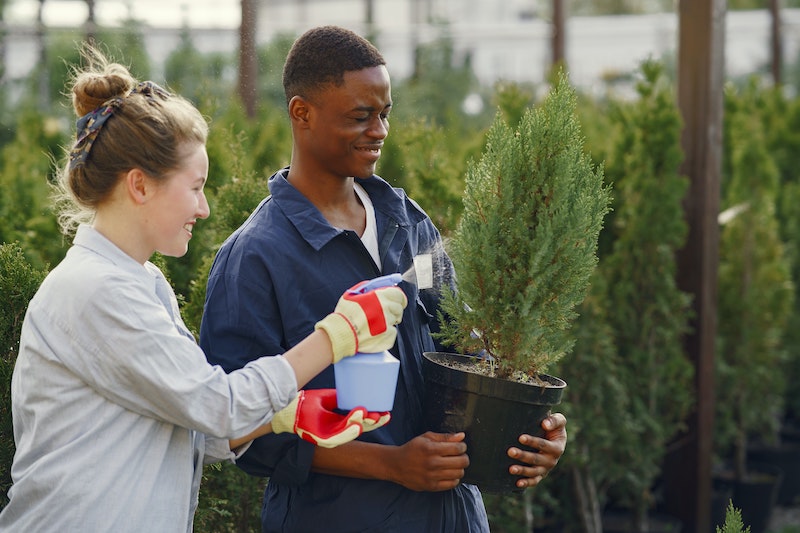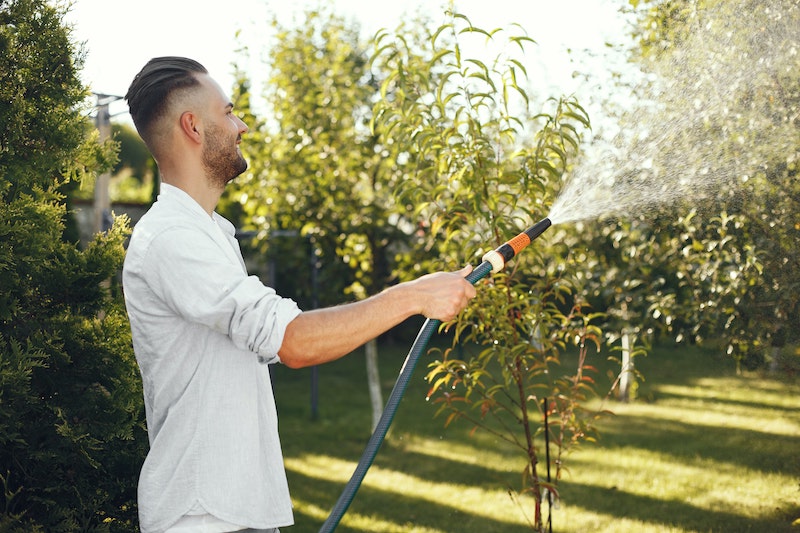Well-sited, established trees and shrubs will need little supplemental watering during periods of ‘normal’ rainfall and summer heat. On the other hand, newly planted shrubs and trees will need extra care and watering for the first few years. Knowing what to look out for in those years of growing trees and shrubs guarantees a long-lived and thriving plant.

How To Tell If Shrubs and Trees Need to be Watered
Trees and shrubs will show the same signs of water stress, drooping or wilting leaves. Often the early stages look like the leaves only flag late in the day, and then revive temporarily with the cooler nighttime temperatures. The keyword is temporarily. Shrubs and trees can keep up this process of wilting and reviving, but it will weaken the plant's overall health.
The best time to water trees and shrubs is when the top 3-4 inches of soil is dry to the touch. This means that the plant is ready for more water and will not run the risk of being overwatered.
How Often To Water Shrubs and Trees
Newly planted shrubs and trees will require a period of babysitting when it comes to a watering schedule. For the first 1-2 weeks, shrubs and trees will require watering every other day to ensure that their roots establish well. If the site is well-draining, then overwatering will not be an issue. If you have heavy soil and slow drainage, water every couple days to ensure the water has time to drain sufficiently.
Watering can be tapered off for the next 3-4 months, typically for the rest of the summer growing season. Aim to provide 1-1 ½ inches of water a week, including any natural rainfall. Space out any supplemental waterings 3-4 days apart. At this time, the roots should show signs of becoming established. A good sign of this is production of more branches and foliage or increased height of a tree.

Mature trees and shrubs will only need extra watering during extended periods of hot and dry weather, or if they are planted near a lawn. Turf growing around trees acts like a groundcover and cools the roots, but it also outcompetes the trees for water, causing stress on the trees or shrubs that may not be seen for one or more seasons. The solution for a tree planted in the lawn is to have the turf removed as far as the tree's drip line.
A 2-3 inch mulch of organic material (arborist chips, compost, finely shredded bark, etc.) should be spread in a ring 12-18 inches from the base of the tree or shrub. Replace or add more mulch every 2-3 years as it decomposes. The mulch will add nutrients to the soil and suppress weeds that compete for water. Only water established trees and shrubs when the top 6 inches of soil are dry. More frequent watering of a tree or shrub that likes to dry out will result in root rot.
Trees and shrubs that are growing in containers may need daily attention during the summer months. Excellent drainage is a crucial element in successfully growing potted trees and shrubs. Water enough that the soil in the container is saturated and not pulling away from the edges of the pot.
Best Time To Water Shrubs and Trees
Early in the day is the best time to water just about any plant. Trees and shrubs that showed signs of water stress the day before will have somewhat revived during the cool night and will use the water efficiently. There will be less evaporation during the cooler morning hours, so that means more water can get to the roots and hydrate the soil.
Trees and shrubs should be kept well watered not only in the spring and summer but during the fall and even the winter if the temperatures exceed 45 degrees F. Trees that are not well watered will not always show signs of stress immediately. The damage may appear one or more years later and may lead to secondary problems, such as pests and disease attacks.

How to Water Shrubs and Trees
Step 1 - Water newly planted shrubs and trees more than established plants.
Daily watering will be needed for the first 2-3 weeks after planting. Watering during the next three months can be reduced to every 2-3 days as the trees show signs of establishing.
Step 2 - Provide 1-1 ½ inches of water per week for established shrubs and trees.
Supplemental watering is only needed when rainfall is lacking. Watering established trees and shrubs too much will lead to root rot and other pests.
Step 3 - Mulch trees that are planted in the lawn.
A grass lawn will compete for water in the soil and can cause trees to be stressed from too little moisture. Mulching the dripline area around a tree helps give trees more moisture and protection from other stressors, such as weed wackers and lawnmowers.
Shrub and Tree Watering Tips
- Remember ‘right plant, right place’. Choose plants based on the conditions you already have in your garden.
- Newly planted shrubs and trees will require careful monitoring for water until they are well established.
- Mulching with a decomposable organic material is best since it will add nutrients and improve the texture of the existing soil.
 |
Author Robbin Small - Published 1-14-2023 |
